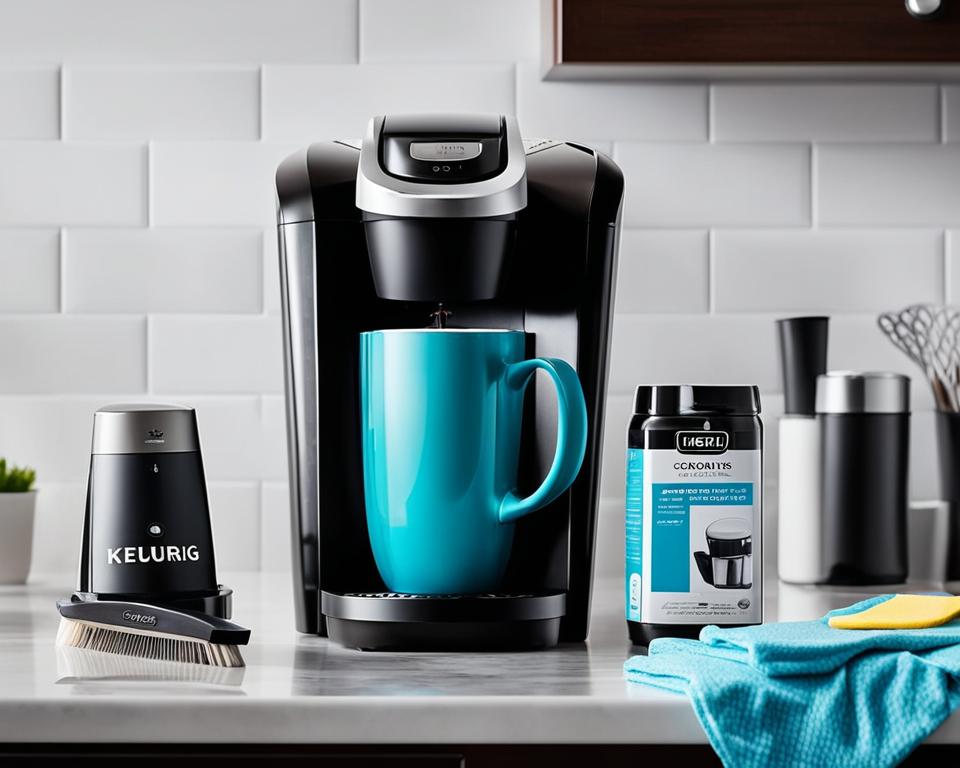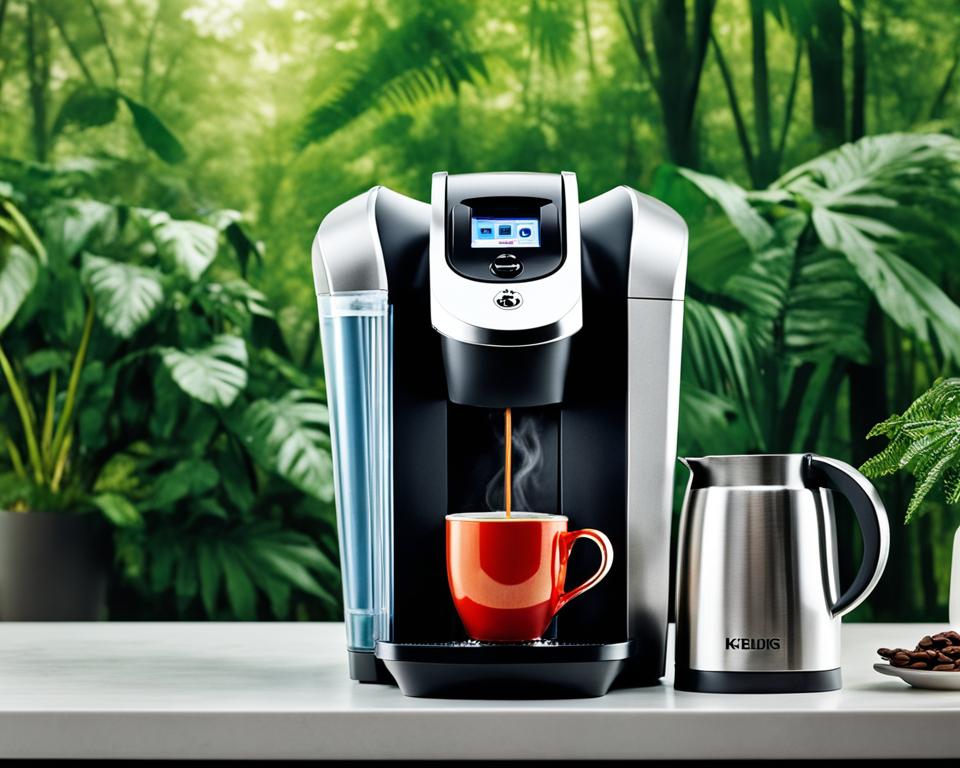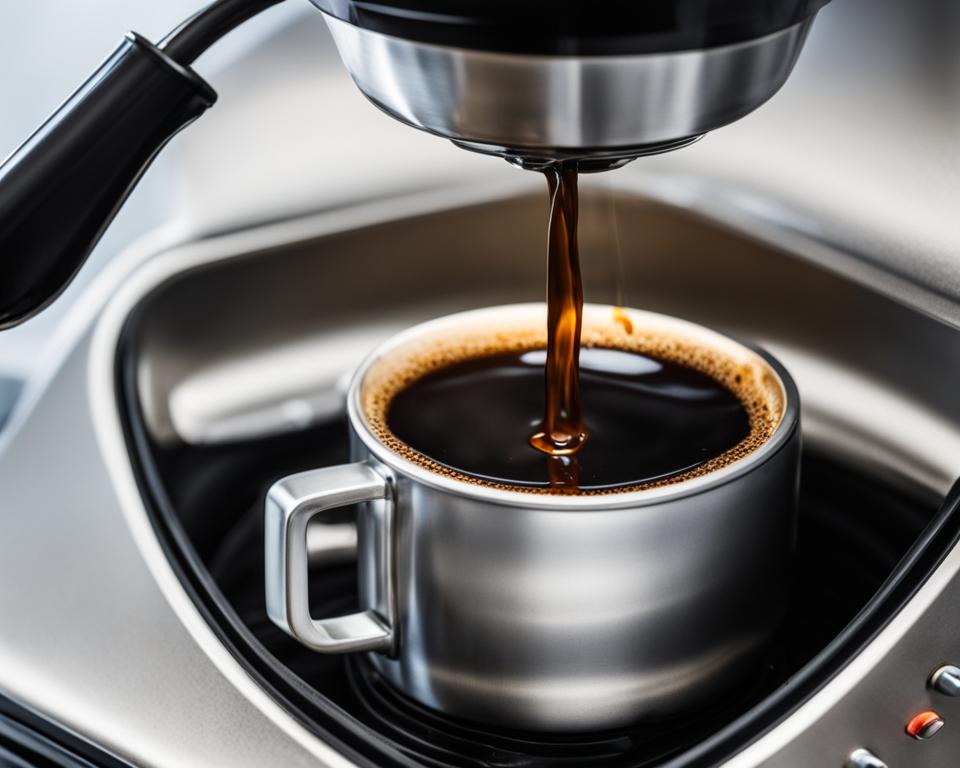The lifespan of a Keurig coffee maker can vary depending on various factors. Regular maintenance, such as periodic inspections and cleanings, is essential to enhance the durability and efficiency of the machine. The quality of the water used in the Keurig also affects its lifespan, as hard water can lead to scale build-up. The frequency of use and the specific model of the Keurig are also factors to consider, as some models are designed for heavy use and may have a longer operational life. With proper care and maintenance, a Keurig coffee maker can last anywhere from 3 to 5 years or even longer.
Key Takeaways:
- A Keurig coffee maker can last from 3 to 5 years or longer with proper care and maintenance.
- Regular maintenance, such as cleanings and inspections, is crucial for enhancing the longevity of the machine.
- The quality of the water used in the Keurig can impact its lifespan, with hard water leading to scale build-up.
- The frequency of use and the specific model of the Keurig are also factors that affect its lifespan.
- Proper care and maintenance practices can extend the life of a Keurig coffee maker and provide continued enjoyment.
Importance of Regular Maintenance for Keurig Coffee Makers
Regular maintenance is crucial for ensuring the optimal performance and longevity of your Keurig coffee maker. By following a few simple maintenance tasks, you can keep your Keurig machine running smoothly and extend its lifespan. Here are some key maintenance practices to keep in mind:
Descaling Your Keurig Coffee Maker
Descaling is an essential maintenance task that involves removing mineral build-up from the internal components of your Keurig machine. Over time, mineral deposits from the water can accumulate and clog the system, affecting the brewing process and the taste of your coffee. It is recommended to descale your Keurig every 3-6 months, or as advised by the manufacturer.
To descale your Keurig coffee maker, you can use commercially available descaling solutions or make your own using white vinegar and water. Follow the instructions provided by Keurig or the descaling solution manufacturer to ensure the process is done correctly. Regular descaling helps prevent clogs and ensures the machine operates at its best.
Cleaning the Exterior and Interior
Alongside descaling, regular cleaning of the exterior and interior of your Keurig machine is essential for maintaining optimal performance. Clean the exterior using a damp cloth to remove any dust or spills. For the interior, clean the pod holder, water reservoir, and drip tray. These parts can be easily removed and rinsed with warm, soapy water. Ensure they are thoroughly dry before reassembling them into the machine.
Inspecting for Wear or Damage
Regularly inspect your Keurig coffee maker for any signs of wear or damage. Check the power cord and plugs for any fraying or damage. Examine the seals and gaskets for wear or leaks. Inspect the brewing needle for any blockages or residue buildup. By addressing any potential issues early on, you can prevent further damage and maintain the machine’s performance.
Using the Right Products
When it comes to maintaining your Keurig machine, using the right products is important. Invest in descaling solutions and cleaning products specifically designed for use with Keurig coffee makers. These products are formulated to effectively remove mineral deposits without causing harm to the internal components of the machine. Using the wrong cleaning solutions may damage the machine and void the warranty.
By following these maintenance tips, you can ensure your Keurig coffee maker remains in excellent condition, delivering delicious cups of coffee for years to come.
| Maintenance Task | Frequency |
|---|---|
| Descaling | Every 3-6 months |
| Exterior cleaning | As needed |
| Interior cleaning | Weekly |
| Inspection for wear or damage | Regularly |
Common Issues and Troubleshooting for Keurig Coffee Makers
Keurig coffee makers are renowned for their convenience and consistent brewing. However, like any appliance, they can encounter common issues that may hinder their performance. Understanding these problems and knowing how to troubleshoot them is essential for maintaining your Keurig machine’s optimal functionality.
Inconsistent Brewing Quantities
One common issue faced by Keurig users is inconsistent brewing quantities. If your Keurig machine is brewing different cup sizes than selected, follow these troubleshooting steps:
- Ensure that the cup size selected matches the actual size of the cup used.
- Check for any debris or clogs in the machine’s exit needle or pod holder. Clean them using a needle or paperclip if necessary.
- Run a water-only brew cycle to flush out any blockages that might be affecting the brewing quantity.
Slow Brewing
If your Keurig machine is brewing coffee at a slower pace than usual, try the following troubleshooting tips:
- Check that the water reservoir is filled to the recommended level. Low water levels can cause slow brewing.
- Verify that the machine is not undergoing the descaling process, as this can temporarily affect brewing speed.
- Perform a descaling cycle to remove any built-up mineral deposits that might be impeding water flow.
Machine Not Turning On
If your Keurig machine fails to turn on, try these troubleshooting steps:
- Ensure that the machine is properly plugged into a working power source.
- Check the power cable for any damages or loose connections.
- Try plugging the machine into a different outlet to rule out any electrical issues.
Leaking
A leaking Keurig machine can be a messy problem. If you’re experiencing leaks, address the issue with these troubleshooting measures:
- Inspect the water reservoir for any cracks or damages. Replace it if necessary.
- Check the alignment of the water reservoir and ensure it is securely in place.
- Clean the exit needle and pod holder thoroughly to eliminate any blockages that might cause leaks.
Unusual Noises During Operation
If your Keurig machine is making unusual noises during operation, troubleshoot the issue using these methods:
- Check for any loose parts or components and tighten them if necessary.
- Clean the machine, paying close attention to the pod holder and exit needle, to remove any debris or coffee grounds that might be causing the noise.
- If the noise persists, it may indicate a mechanical issue. Contact Keurig customer support for further assistance.
Taste Issues
Keurig coffee machines are designed to brew flavorful coffee, but sometimes the taste may not meet your expectations. To troubleshoot taste issues, follow these steps:
- Use filtered or bottled water instead of tap water, as mineral content in tap water can affect the coffee’s taste.
- Regularly clean and descale your machine to remove any mineral build-up.
- Ensure that coffee pods are fresh and properly stored in a cool, dry place.
Error Messages
If your Keurig machine displays an error message, consult the user manual or Keurig’s website for specific troubleshooting instructions. Error messages often provide valuable information about the underlying issue and how to resolve it.
By following these troubleshooting tips, you can address common issues with your Keurig coffee maker and get it back to brewing delicious coffee with ease.
| Common Issue | Troubleshooting Steps |
|---|---|
| Inconsistent brewing quantities | 1. Ensure cup size selection matches cup size used. 2. Check for clogs in exit needle or pod holder. 3. Run a water-only brew cycle. |
| Slow brewing | 1. Check water reservoir level. 2. Verify machine is not descaling. 3. Perform a descaling cycle. |
| Machine not turning on | 1. Check power source and cable. 2. Try a different outlet. |
| Leaking | 1. Inspect water reservoir for damages. 2. Check reservoir alignment. 3. Clean exit needle and pod holder. |
| Unusual noises | 1. Check for loose parts. 2. Clean machine thoroughly. 3. Contact customer support if noise persists. |
| Taste issues | 1. Use filtered or bottled water. 2. Clean and descale machine regularly. 3. Ensure fresh and properly stored coffee pods. |
| Error messages | Refer to user manual or Keurig’s website for specific instructions. |
Tips to Increase the Lifespan of Your Keurig Machine
To ensure your Keurig coffee maker lasts longer, there are several tips and practices you can follow. By implementing these strategies, you can extend the lifespan of your Keurig machine, increase its durability, and maximize its longevity.
1. Use filtered or soft water:
Using filtered or soft water instead of hard water can significantly reduce the risk of mineral build-up and scale formation in your Keurig machine. Hard water can cause deposits to accumulate over time, affecting the machine’s performance and lifespan.
2. Regular cleaning and descaling:
Regularly cleaning and descaling your Keurig machine is essential to prevent performance issues and prolong its life. Follow the recommended maintenance schedule provided by the manufacturer. This includes descaling the machine every few months to remove mineral deposits and ensuring thorough cleaning of all accessible parts.
3. Empty and clean the water reservoir:
Regularly emptying and cleaning the water reservoir, especially if the machine is not in frequent use, can prevent the development of algae or mold. Stagnant water can lead to bacterial growth and affect the overall quality and functionality of your Keurig machine.
4. Use the right products and accessories:
When descaling and cleaning your Keurig machine, make sure to use the recommended products and accessories. These products are specifically designed to maintain the machine’s performance without causing any harm or damage. Following the manufacturer’s guidelines will help preserve the lifespan of your Keurig machine.
5. Proper storage and handling:
Proper storage and handling of your Keurig machine can also contribute to its longevity. Store the machine in a cool, dry place, away from direct sunlight and extreme temperatures. Avoid placing heavy items on top of the machine, as it can cause internal damage over time.
By implementing these tips and practices, you can extend the lifespan of your Keurig machine, ensuring many years of delicious coffee brewing.

Best Practices for Using Your Keurig Machine
To get the most out of your Keurig coffee maker and ensure its optimal performance, there are several best practices to follow:
- Regularly replace the water filter. Using filtered water helps prevent mineral build-up and maintains water quality, resulting in better-tasting coffee.
- Clean removable parts, such as the pod holder and water reservoir, on a weekly basis. This prevents coffee grounds or residues from affecting the taste and aroma of the coffee.
- Keep your Keurig machine in a cool, dry place to protect it from moisture and potential damage. Regularly inspect the machine for any signs of wear or issues to address them promptly.
Following the recommended brewing and maintenance instructions provided by Keurig is crucial to maximize the performance of your machine. Remember to consult the user manual for specific guidelines and troubleshooting tips.

Following these best practices will help you maximize the performance and lifespan of your Keurig machine, ensuring you can enjoy delicious coffee for years to come.
Conclusion
In conclusion, Keurig coffee makers are designed to provide convenience and delicious coffee for several years. With proper care and maintenance, you can extend the lifespan of your Keurig machine and continue to enjoy its benefits. Regularly descaling and cleaning your Keurig is crucial to maintain optimal performance and prevent mineral build-up. Using filtered or soft water can also help prevent scale formation and prolong the life of your machine.
It is important to address any issues or signs of wear promptly to prevent further damage. By following best practices for cleaning, maintenance, and usage, you can increase the longevity of your Keurig coffee maker. Remember to replace the water filter regularly and clean removable parts to ensure the best-tasting coffee. By implementing these tips and practices, you can maximize the lifespan of your Keurig machine and continue to enjoy a fresh cup of coffee every morning.
With proper care, your Keurig coffee maker can last for 3 to 5 years or even longer. By extending its lifespan, you can save money and reduce electronic waste. So, take the time to maintain your Keurig machine and follow the recommended guidelines. With these efforts, your Keurig will continue to be your favorite morning companion for years to come.
FAQ
How long does a Keurig coffee maker last?
The lifespan of a Keurig coffee maker can vary depending on various factors, but with proper care and maintenance, a Keurig coffee maker can last anywhere from 3 to 5 years or even longer.
Why is regular maintenance important for Keurig coffee makers?
Regular maintenance is crucial for ensuring the optimal performance and longevity of a Keurig coffee maker. This includes tasks like descaling every 3-6 months, cleaning the machine regularly, and inspecting it for any signs of wear or damage.
What are some common issues with Keurig coffee makers, and how can they be resolved?
Some common issues with Keurig coffee makers include inconsistent brewing, slow brewing, the machine not turning on, leaking, unusual noises, and taste issues. Troubleshooting steps can involve descaling, checking for obstructions, ensuring proper power and water reservoir positioning, and inspecting for any damages or issues with the machine’s seals or pump.
What tips can help increase the lifespan of a Keurig coffee maker?
Using filtered or soft water, regularly cleaning and descaling the machine, emptying and cleaning the water reservoir, using the right products and accessories, and adhering to proper storage and handling practices can help increase the lifespan of a Keurig coffee maker.
What are the best practices for using a Keurig coffee maker?
Best practices for using a Keurig coffee maker include regularly replacing the water filter, using filtered water, cleaning removable parts weekly, keeping the machine in a cool, dry place, and following the recommended brewing and maintenance instructions provided by Keurig.

Leave a Reply